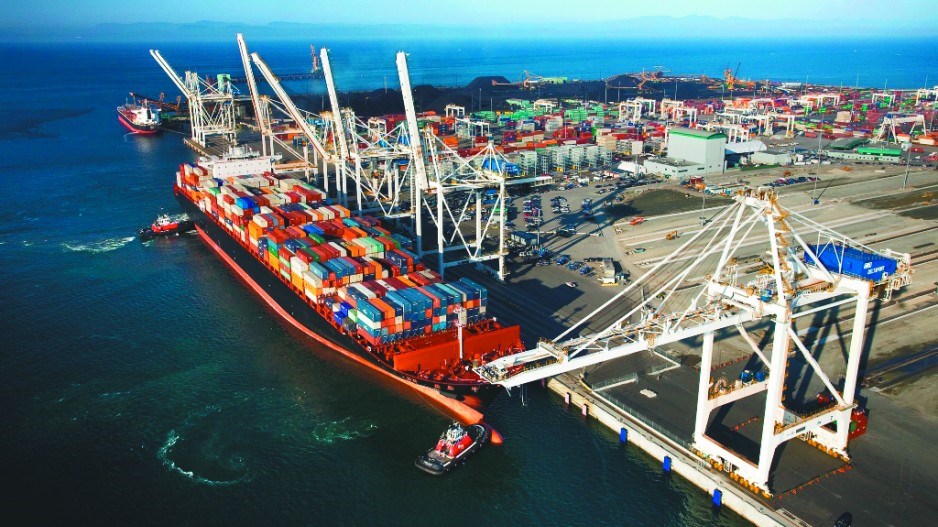The labour disruptions that stalled container cargo flow through ports along the U.S. West Coast from mid-2014 through early 2015 might be over, but concerns about the long-term reliability of those ports have major global shippers looking to permanently reroute cargo to East Coast North American ports.
That could have a domino effect on container traffic through B.C. ports. But it could also continue the diversion of containers north that occurred during the eight months of negotiations between the International Longshore and Warehouse Union (ILWU) and the Pacific Maritime Association that included work stoppages and cargo handling slowdowns.
A tentative agreement was reached between the two sides in late February, and while the ILWU has recommended its membership accept the deal, union votes won’t be counted until May 22.
Meanwhile, according to an American Shipper magazine poll of shippers and logistics companies, half of the survey’s respondents are now considering East Coast port options because of the economic pain suffered during the protracted port labour negotiations coupled with their concerns about the long-term reliability of West Coast ports.
According to Won’t Be Fooled Again, How BCOs Plan to Avoid the Pitfalls of West Coast Port Congestion, approximately 40% of shippers that now use West Coast ports exclusively are considering using East Coast ports.
More significantly, said the report, “roughly half of shippers that already use ports on both coasts say they plan to shift cargo from west to east because of the congestion.”
The American Shipper report added that a third of retailers and one-fourth of manufacturers plan to add or move to distribution centres on the East Coast. On average, the survey respondents said they plan to move 20% of their volume from west to east.
The report pointed out that a larger percentage of major beneficial cargo owners (BCOs) than their small to mid-sized counterparts plan to shift volume east.
“These numbers should trouble stakeholders at West Coast ports,” stated the report, “because they indicate a willingness from the large BCOs they covet to shift cargo patterns on a long-term basis. And more than a third of large shippers, those with $1 billion or more in revenue, say they plan to add, or relocate to, [distribution centres] on the East Coast.”
In an April Wall Street Journal story, a retail strategist with consulting firm Kurt Salmon estimated that the cumulative costs of shipping delays caused by the labour dispute could hit US$7 billion in 2015.
Widening of the Panama Canal, expected to be completed in 2016, will give global ocean carriers’ new mega-container ships ready access to U.S. Gulf Coast and East Coast container ports. Other options for shippers include using more air and sea freight combinations that allow them to move cargo from Asia to ports like Dubai, then on to North America’s eastern seaboard.
However, local ports operators are confident that there will be minimal collateral damage to container traffic through B.C. container terminals from shippers’ disaffection over the longshore labour dispute.
Maksim Mihic, general manager, DP World Vancouver, which owns Vancouver’s Centerm container terminal, said the low Canadian dollar, better infrastructure and service and cheaper railway costs in B.C. will continue to be a draw for global shipping companies.
Port Metro Vancouver (PMV) spokesman John Parker-Jervis added that, even with an improved Panama Canal, PMV will remain “a competitive option for getting cargo to major eastern Canadian destinations.”
Container traffic numbers support that optimism.
According to PMV stats, year-to-date container traffic through PMV as of March is higher than last year. Total 20-foot equivalent units (TEUs) shipped through the port hit 735,219, up 15.2% compared with the same period in 2014. The percentage increase at the Port of Prince Rupert is also up significantly. As of April, year-to-date TEUs shipped through the port hit 251,081, up 42% compared with the same period in 2014.
In March, the operator of the port’s Fairview Container Terminal announced plans for a $200 million expansion of the seven-year-old facility that will increase Prince Rupert’s container cargo handling capacity by approximately 60%.
With an annual capacity of 850,000 TEUs, Prince Rupert is a relatively small player in the US$4 trillion global container cargo trade, but the port continues to grow rapidly.
According to the Journal of Commerce, Prince Rupert, with 13.8% year-over-year growth, was North America’s fastest-growing port in 2014.
In early April, Dubai-based DP World Ltd. signed a deal to acquire Fairview from Deutsche Bank (NYSE:DB) for $580 million.
In a conversation with BIV last year, Walter Kemmsies, chief economist at Moffatt & Nichol, a major port engineering and consulting firm, pointed out that the macroeconomics of Asian manufacturing will also have a significant impact on container traffic flow to North America’s West Coast.
Kemmsies said a gradual shift in Asian manufacturing centres to south Asia (India, Vietnam, Thailand) from north Asia (China, Japan, Korea, Taiwan) will move containers farther from Vancouver. He added that the growth of manufacturing in Mexico puts containers directly on rail to the North American heartland without having to be unloaded at any West Coast port.
According to U.S. Census Bureau numbers, the percentage of exports to the U.S. from north Asia dropped to around 81% in 2014 from 85% in 2008, while the percentage from south Asia rose to approximately 19% from 15%.
“This is significant, what is going on,” Kemmsies said. “It’s not a trivial thing.”




